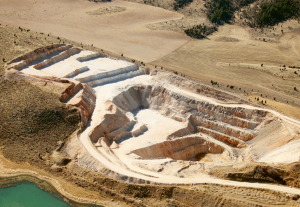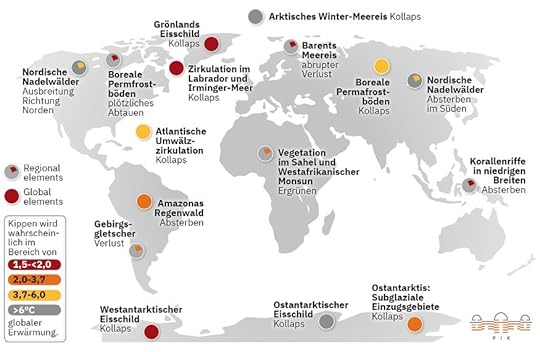Steve Bull's Blog, page 191
September 17, 2022
Approaching peak phosphorus
Any long-term solution to the projected decline in phosphate supply must involve improving phosphorus use efficiency in crop plants.
In times of rising food prices and global food insecurity it is important to remember the basic needs for productive and efficient agriculture. One of these needs is the use of fertilizer. While much research focuses on the problem of overfertilization and its negative environmental impacts, mostly due to nitrogen runoff, another reason to rethink the wasteful use of fertilizer is that complete fertilizer is a non-renewable resource due to its phosphorus component, an essential plant macronutrient that is almost exclusively mined as the mineral phosphorite, also known as rock phosphate.
 Credit: RMBrown / Alamy Stock Photo
Credit: RMBrown / Alamy Stock PhotoOver 70% of global phosphorite reserves are held by Morocco, followed by China with 5%, Syria and Algeria with 3% each, and Russia, South Africa, the US, Egypt and Jordan with 2% each. However, agriculture does not just depend on phosphorite reserves, but on the whole fertilizer production process, which requires a functioning phosphorus supply chain. Production is influenced by political and economic factors such as war and conflict. Despite its vast reserves, Morocco is only the second largest phosphate producer, due to ongoing tensions with Western Sahara and high costs of mining. Therefore, it should be kept in mind that not only are the reserves critical for food security, but that the immediate accessibility of phosphates to farmers is also critical for food security. Global reserves that are accessible at a reasonable cost of mining are important in the long term, but how long will these reserves last?
Geophysicist Marion King Hubbert formulated the concept of peak oil in 1956, reminding us that the planet’s resources are not infinite. Decades later, and attracting much less attention, a similar idea was established for phosphorus, and it was predicted that its peak could be reached globally as soon as 20331…
…click on the above link to read the rest of the article…
September 16, 2022
IMF Chief: Harsh Winter May Spark Social Unrest In EU Amid Energy Crisis
A number of countries in Europe may experience social unrest if the upcoming winter is harsh amid an economic crisis, the head of the International Monetary Fund (IMF) warned on Wednesday.
“There is certainly fear of recession in some countries, or even if it is not recession, that it would feel like recession this winter,” said Kristalina Georgieva, managing director of the IMF.
“And if Mother Nature decides not to cooperate, and the winter is actually harsh, that could lead to some social unrest,” she added.
Attending the 2022 “Michel Camdessus Central Banking Lecture” held in Washington, D.C., Georgieva pointed out that Europe is directly affected by Russia’s attack on Ukraine, saying the war has led to “horrible” economic consequences and added fuel to fears of recession in some countries.
Georgieva said the current situation meant that the European Central Bank needed to be “mindful of the necessity to keep the economy going,” while also remaining persistent in fighting broad-based inflation.
“Inflation is stubborn, it is more broad-based than we thought it would be,” Georgieva said. “And what it means is … we need central bankers to be as stubborn in fighting it as inflation has demonstrably been.”
Second-Order Effects
Georgieva noted at the event that the global economy had two consecutive shocks, the COVID-19 pandemic and Russia’s attack on Ukraine, which contributed to surging prices and a cost-of-living crisis.
The disruptions in the flows of Russian gas to Europe remain the primary cause of Europe’s current energy crisis. The continent has relied upon cheap Russian energy for years to power factories, generate electricity, and heat homes.
…click on the above link to read the rest of the article…
September 14, 2022
A Few of the Things We Can Do On the Way Down From Peak Humanity
 Photo by Michiel Annaert on UnsplashA Few of the Things We Can Do On the Way Down From Peak Humanity
Photo by Michiel Annaert on UnsplashA Few of the Things We Can Do On the Way Down From Peak HumanityI think we’re done. Well, almost.
I saw the first movie The Matrix when it came out in theaters. I remember how they depicted the height of humanity in 1999. I remember how I felt watching the scene where they recounted the history of the Matrix and how it came to be. I recall seeing the tall shiny building with “Malfa” on the side, and the well-dressed people walking on the virtual street. Then there was the virtual woman in the red dress. At the time, that was peak humanity to me.
23 years later, I can’t help but think we’ve crested the peak of humanity. I see our birth rates declining, our education systems declining, and our general welfare declining. There used to be a recognizable sense of optimism in America. I don’t see it now. There used to be a sense that we could recover from our setbacks, but that’s gone, too.
And yet I also see a sense of relief. It’s like humans have finally realized that they’re stressing the planet too much and that we must make a change. We need to use restraint. I also see that the damage we’ve done to the earth has placed very real constraints on our capacity to grow.
A recent study has shown that air pollution significantly increases our risk of cancer. Another study has shown that microplastics are making us obese. And yet another study has shown that hormone disruptors have cut our birthrates. We’re still trying to figure out what forever chemicals are doing to our bodies. If we’re not careful, by 2050 in vitro fertilization will be required to have kids because pollution is such an effective contraceptive.
…click on the above link to read the rest of the article…
Europe’s Natural Gas Shortage Could Trigger A Food Crisis
The problem with an energy crisis is that it’s actually an everything crisis. In a world where virtually every industry relies on energy in some form, runaway inflation is an inevitability. This phenomenon is not news – you’ve been experiencing it for the better part of two years now. But while global governments are using every tool in their kits to curb the rising inflation rates, there’s far less they can do about the coming food shortage.
For months, the agricultural industry has been warning the rest of the world that next year’s food production is severely threatened, as the fertilizer industry is in shambles. Industrial NPK fertilizers (so named for their makeup of nitrogen, phosphorus, and potassium oxide), are heavily reliant on natural gas supplies. About 70 percent of the cost of fertilizer production is solely the price of natural gas, which is used in liberal amounts to make the ammonia phosphate slurries that turn into fertilizer. Indeed, according to CRU Group, European fertilizer producers in the region are currently losing approximately $2,000 for every ton of ammonia produced. So as Russia has stemmed and then indefinitely stopped the flow of natural gas into Europe, sending gas prices through the roof, the continent’s fertilizer sector has halted as much as 70 percent of its production capacity.
…click on the above link to read the rest of the article…
Death by Hockey Sticks

Courtesy Pixabay (PhotoMIX-Company)
You may be familiar with the term “hockey stick curve,” used describe a trend that has been flat/stable for a very long time, but shoots up at the end of the series in dramatic fashion, resembling the shape of a hockey stick. Hockey can be a violent sport, and it’s easy to get hurt by even one well-aimed swing. Today’s world is being battered from all sides by countless hockey sticks. Mostly, they seem to be targeting Earth’s critters, who are getting bludgeoned unsparingly. But in the end, we’re only harming ourselves.
This post is structured as a gauntlet of hockey stick curves that may leave the reader feeling a bit bruised. Depending on what’s being plotted, many of the graphs shoot up like an exponential, but a few are careening downwards. A theme emerges: the “bads” go up, and the “goods” go down—and not by coincidence.
People and Money
We’ll start simply. Human population looks like a hockey stick curve. This is not a surprise to anyone. The fact is greeted with a range of reactions from joy to despair, but mostly simple acceptance. Whatever your disposition, here’s what it looks like.

Human Population
All the plots in this post will share the same time axis, from the year 1000 to 2200—even for those lacking information across the whole span. The point will be to emphasize the anomalous nature of recent history: what I call the fireworks show. Maybe it would be more fair to use a 10,000 year span (civilization), or 200,000 for modern homo sapiens, or even 3 million years for the entire human saga. On such scales, the present era loses its graceful curve and looks rather more like a sudden brick wall.
…click on the above link to read the rest of the article…
September 13, 2022
Intense heat and flooding are wreaking havoc on power and water systems as climate change batters America’s aging infrastructure
The 1960s and 1970s were a golden age of infrastructure development in the U.S., with the expansion of the interstate system and widespread construction of new water treatment, wastewater and flood control systems reflecting national priorities in public health and national defense. But infrastructure requires maintenance, and, eventually, it has to be replaced.
That hasn’t been happening in many parts of the country. Increasingly, extreme heat and storms are putting roads, bridges, water systems and other infrastructure under stress.
Two recent examples – an intense heat wave that pushed California’s power grid to its limits in September 2022, and the failure of the water system in Jackson, Mississippi, amid flooding in August – show how a growing maintenance backlog and increasing climate change are turning the 2020s and 2030s into a golden age of infrastructure failure.
I am a civil engineer whose work focuses on the impacts of climate change on infrastructure. Often, low-income communities and communities of color like Jackson see the least investment in infrastructure replacements and repairs.
Crumbling bridge and water systems
The United States is consistently falling short on funding infrastructure maintenance. A report by former Federal Reserve Board Chairman Paul Volcker’s Volcker Alliance in 2019 estimated the U.S. has a US$1 trillion backlog of needed repairs.
Over 220,000 bridges across the country – about 33% of the total – require rehabilitation or replacement.
A water main break now occurs somewhere in the U.S. every two minutes, and an estimated 6 million gallons of treated water are lost each day. This is happening at the same time the western United States is implementing water restrictions amid the driest 20-year span in 1,200 years. Similarly, drinking water distribution in the United States relies on over 2 million miles of pipes that have limited life spans.
…click on the above link to read the rest of the article…
September 12, 2022
JOHN PILGER: Silencing the Lambs — How Propaganda Works
Leni Riefenstahl said her epic films glorifying the Nazis depended on a “submissive void” in the German public. This is how propaganda is done.

Leni Riefenstahl, center, filming with two assistants, 1936. (Bundesarchiv, CC-BY-SA 3.0, Wikimedia Commons)
In the 1970s, I met one of Hitler’s leading propagandists, Leni Riefenstahl, whose epic films glorified the Nazis. We happened to be staying at the same lodge in Kenya, where she was on a photography assignment, having escaped the fate of other friends of the Fuhrer.
She told me that the “patriotic messages” of her films were dependent not on “orders from above” but on what she called the “submissive void” of the German public.
Did that include the liberal, educated bourgeoisie? I asked. “Yes, especially them,” she said.
I think of this as I look around at the propaganda now consuming Western societies.
Of course, we are very different from Germany in the 1930s. We live in information societies. We are globalists. We have never been more aware, more in touch, better connected.
Or do we in the West live in a Media Society where brainwashing is insidious and relentless, and perception is filtered according to the needs and lies of state and corporate power?
The United States dominates the Western world’s media. All but one of the top 10 media companies are based in North America. The internet and social media – Google, Twitter, Facebook – are mostly American owned and controlled.
In my lifetime, the United States has overthrown or attempted to overthrow more than 50 governments, mostly democracies. It has interfered in democratic elections in 30 countries. It has dropped bombs on the people of 30 countries, most of them poor and defenceless. It has attempted to murder the leaders of 50 countries. It has fought to suppress liberation movements in 20 countries.
…click on the above link to read the rest of the article…
September 11, 2022
Risk of passing multiple climate tipping points escalates above 1.5°C global warming
 Tipping points world map. Figure by Biermann/PIK, based on Armstrong McKay et al, 2020
Tipping points world map. Figure by Biermann/PIK, based on Armstrong McKay et al, 2020The research, published in advance of a major conference “Tipping Points: from climate crisis to positive transformation” at the University of Exeter (12-14th September), concludes human emissions have already pushed Earth into the tipping points danger zone. Five of the sixteen may be triggered at today’s temperatures: the Greenland and West Antarctic ice sheets, widespread abrupt permafrost thaw, collapse of convection in the Labrador Sea, and massive die-off of tropical coral reefs. Four of these move from possible events to likely at 1.5°C global warming, with five more becoming possible around this level of heating.
Lead author David Armstrong McKay from Stockholm Resilience Centre, University of Exeter, and the Earth Commission says, “We can see signs of destabilisation already in parts of the West Antarctic and Greenland ice sheets, in permafrost regions, the Amazon rainforest, and potentially the Atlantic overturning circulation as well.”
“The chance of crossing tipping points can be reduced by rapidly cutting greenhouse gas emissions”
“The world is already at risk of some tipping points. As global temperatures rise further, more tipping points become possible.” he adds. “The chance of crossing tipping points can be reduced by rapidly cutting greenhouse gas emissions, starting immediately.”
…click on the above link to read the rest of the article…




